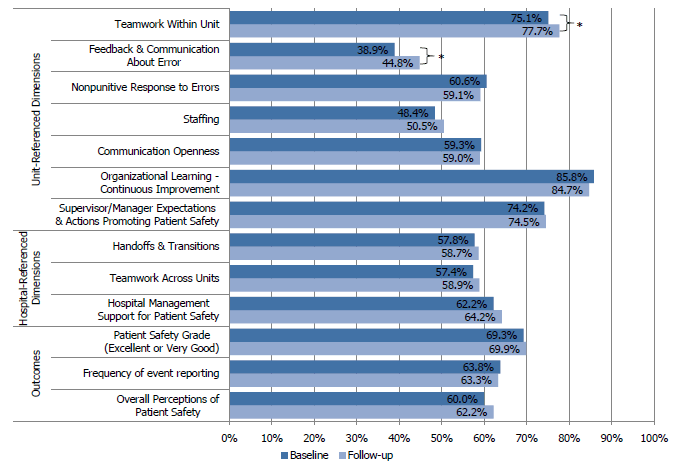HSOPS
Section Summary
- The Hospital Survey on Patient Safety Culture (HSOPS) was administered at baseline and at follow-up in all units.
- Among adult ICUs, a statistically significant improvement was found in two dimensions: "feedback and communication about error" and "teamwork within unit." No statistically significant differences were found among the remaining HSOPS dimensions.
The Hospital Survey on Patient Safety Culture (HSOPS) is a reliable and valid survey13 designed to assess clinician and staff perceptions of the culture of safety within their unit and overall hospital. The instrument contains seven unit-level safety culture dimensions, four hospital-level dimensions, and four outcome variables.
Methods
HSOPS data were collected during two time periods: at the start of project participation and during a follow-up period near project completion. Participating units were invited to collect fresh HSOPS data from unit staff members or to upload previously collected survey data collected during annual safety culture surveys conducted by their organizations. To be included in analyses, units had to be an adult ICU and have a baseline and follow-up survey response rate between zero and 100 percent. Analyses were carried out to test the change in perceptions of safety culture and to mirror as closely as possible the methods used reported in the original Michigan Study and reported by Sexton et al. (2011).14 It should be noted that the study published by Sexton et al. examined the Safety Attitude Questionnaire, an instrument containing a single "safety climate" dimension while the HSOPS measures 10 dimensions of the safety culture construct as well as 4 outcome variables. Analyses of baseline/follow-up changes in HSOPS dimension scores were assessed using a two-tailed, paired samples t-test with Bonferonni correction for multiple tests. Dimensions with a statistically significant change were further examined to assess the changes in the number of units classified as "needing improvement" (defined as a score of less than 50 percent, a threshold suggested within the HSOPS user's manual). Changes in classification were assessed using McNemar's test.
Results
Results among adult ICUs with baseline and follow-up response rates between zero and 100 percent (n=302) can be found in Table 18 and Figure 18. A statistically significant improvement was found for two dimensions: "feedback and communication about error" (38.9 percent at baseline versus 44.8 percent at follow-up; p<0.01) and "teamwork within unit" (75.1 percent baseline versus 77.7 percent at follow-up; p<0.01). The number of units classified as "needing improvement" within the "feedback and communication about error" dimension was statistically significantly reduced by 22 percent (77.8 percent of units at baseline versus 63.9 percent of units at follow-up; p<.001). However, the number of units classified as "needing improvement" within the "teamwork within units" dimension did have a statistically significant change (4.3 percent of units at baseline versus 5.3 percent of units at follow-up). There were no statistically significant changes in other dimensions of the HSOPS.
Table 18. Baseline and follow-up HSOPS scores by dimension in adult ICUs (n=302)
| Mean Percent Positive Dimension Scores | Difference | p-value | |||
|---|---|---|---|---|---|
| Baseline | Follow-up | Mean | Stdev | ||
| Outcomes | |||||
| Overall Perceptions of Patient Safety | 60.0% | 62.2% | -0.023 | 0.168 | 0.019 |
| Frequency of event reporting | 63.8% | 63.3% | 0.004 | 0.170 | 0.663 |
| Pt. Safety Grade (Excellent or Very Good) | 69.3% | 69.9% | -0.006 | 0.198 | 0.569 |
| Hospital-Referenced Dimensions | |||||
| Hospital Management Support for Patient Safety | 62.2% | 64.2% | -0.019 | 0.152 | 0.027 |
| Teamwork Across Units | 57.4% | 58.9% | -0.015 | 0.143 | 0.068 |
| Handoffs and Transitions | 57.8% | 58.7% | -0.008 | 0.164 | 0.381 |
| Unit-Referenced Dimensions | |||||
| Supervisor/Manager Expectations & Actions Promoting Patient Safety | 74.2% | 74.5% | -0.003 | 0.140 | 0.686 |
| Organizational Learning—Continuous Improvement | 85.8% | 84.7% | 0.012 | 0.114 | 0.080 |
| Communication Openness | 59.3% | 59.0% | 0.003 | 0.141 | 0.698 |
| Staffing | 48.4% | 50.5% | -0.020 | 0.144 | 0.015 |
| Nonpunitive Response to Errors | 60.6% | 59.1% | 0.015 | 0.167 | 0.114 |
| Feedback and Communication About Error | 38.9% | 44.8% | -0.059 | 0.183 | <0.001* |
| Teamwork Within Unit | 75.1% | 77.7% | -0.026 | 0.153 | 0.003* |
Figure 18. Baseline and follow-up HSOPS scores by dimension among adult ICUs (n=302)

13. Agency for Healthcare Research and Quality, HSOPS Safety Culture Items and Dimensions at: http://www.ahrq.gov/professionals/quality-patient-safety/patient-safety-resources/patientsafetyculture/hospdim.html.
14. Sexton JB, Berenholtz SM, Goeschel SR, et al. Assessing and improving safety climate in a large cohort of intensive care units. Critical Care Medicine 2011;39(5):934-999.



